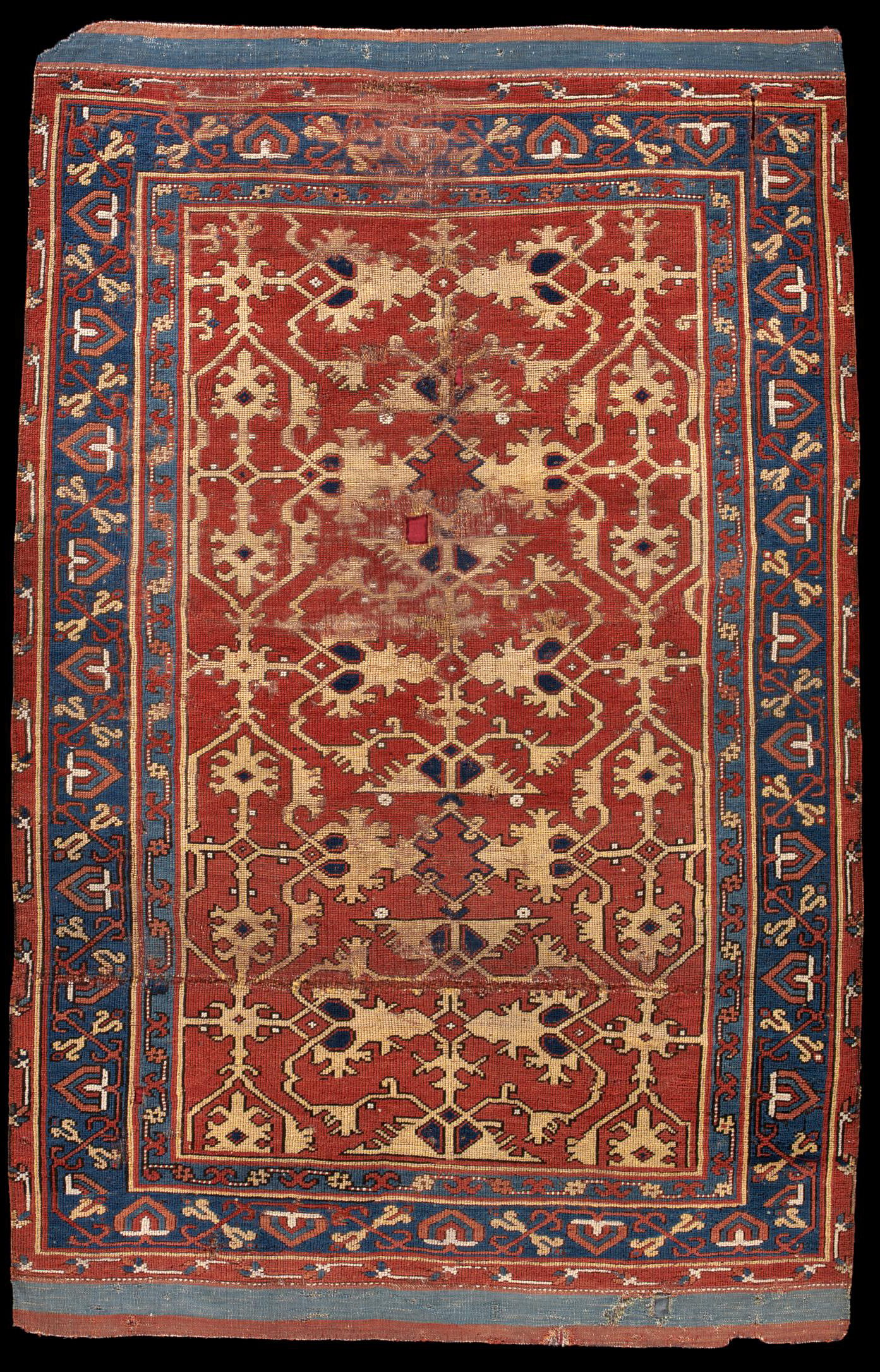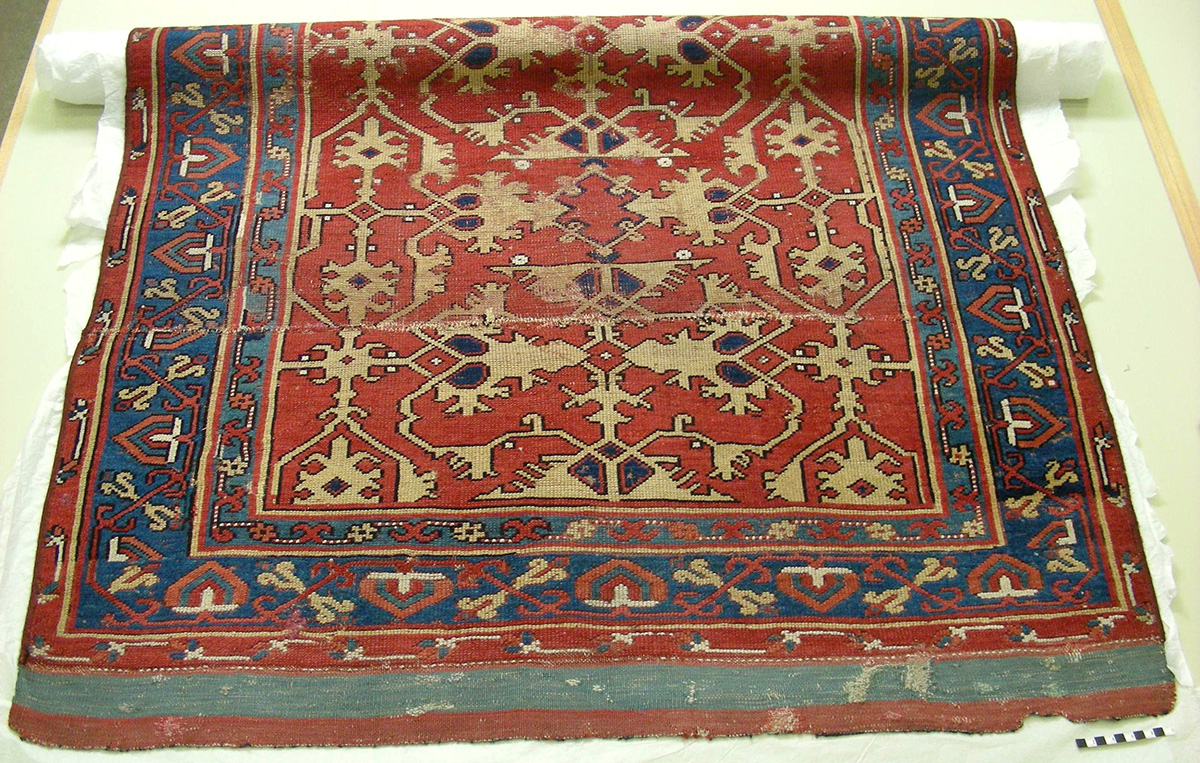Place of origin: Turkey (made)
Materials and Techniques: Hand
knotted woollen pile, on woollen warp and weft; symmetrical knot; 80 knots
per sq. in (640 per sq. dm)
Gallery location: Medieval &
Renaissance, Room 63, The Edwin and Susan Davies Gallery, case WN, shelf
EXP
Carpets with this distinctive yellow and red design are often
called the Lotto carpets because the Italian artist Lorenzo Lotto
[c.1480-1556] is said to have depicted several in his paintings.
There
are two obvious features in this carpet: a large area of re-knotting in
the centre and the fact that the upper border has been knotted in slightly
different colours - the dark brown used in the other three borders is
missing. This yellow and red design was popular for over a century. It was
worked from drawings and so its proportions could be easily changed by
selecting which part of the repeating design was to be woven. There is
horizontal repair across most of the upper part of this carpet. If you
look at the left hand end (just inside the red field) you will see that
the lines of knots above and below the repair are not parallel. This part
of the carpet was badly woven and a ridge would have formed when it was on
the floor. Someone later cut the carpet and rejoined it to make it lie
flat.
Physical description
Carpet, Lotto design, hand
knotted woollen pile on woollen warp and weft, Turkish, 16th/17th century
WARP: light brown wool; Z2S; 16 threads per inch (64 per dm)
WEFT:
light red wool; Z-spun , unplied; 2 shoots after each row of knots; 10
knots per inch (40 per dm)
PILE: wool; 9 colours: red, light red,
yellow, green, dark blue, blue, light blue, dark brown, white; symmetrical
knot tied around two threads; 80 knots per inch (640 per sq. dm)
SIDE
FINISH: one cord oversewn with red wool
END FINISH: Both incomplete.
Lower: 3 cm plain weave with red weft followed by 4 cms plain weave with
green weft and then by 1 cm plain weave with red weft in the middle of
which is one pass of thick white weft which goes over 2 threads and under
2 threads. Upper: as lower but the outer band of plain weave with red weft
is only 2 cms deep.
DESIGN: Field: red ground with a typical Lotto
design with yellow arabesques and blue infillings frequently outlined with
red.
Main border: blue ground with an angular red meander linking
alternately inward- and outward-facing red/blue triangles. The diagonal
bar of the meander is crossed by a pair of yellow flowers.
Inner
border: light blue ground with a red and white dotted meander linking
flowerheads and a pair of leaves.
Outer Border: red ground with a
white meandering stem in the upper and lower borders; in the side borders
the stems is not continuous.
Catalogue Date: 8.3.96
Dimensions:
Height: 181.5 cm, Width: 116.5 cm
Bibliographic References
(Citation, Note/Abstract, NAL no): Ajmar-Wollheim, Marta and Flora Dennis,
At Home in Renaissance Italy, London: V&A Publishing, 2006.
Carpets were a popular feature of interiors across Italy, particularly in
Venice with its trade links with the Middle East. They were draped over
furniture to conceal plain surfaces, and hung from balconies on special
occasions, but only sometimes put on the floor. The distinctive design of
this carpet is named after Lorenzo Lotto, who often included such carpets
in his paintings. [62 words]
Western Turkey, probably Ushak
Wool; cut horizontally and rejoined at a later date
V&A: T.348-1920
[5 Oct 2006 - 7 Jan 2007]
Production Note
Western Turkey,
probably Ushak. Purchased with 4 other pieces (T.349/352-1920) from Harold
Wallis Esq., St. Albans, Godstone Road, Purley, from his father's estate.
for £35/-/-.
1 rug, Asia Minor, arabesques in yellow on red ground.
Illustration and comment "Turkish Carpets in the V & A", by M. Franses
& R. Pinner (intro by Donald King), analyses by S. Jarman. Hali 1984, Vol.
6, no.4, p. 354, 365, 367, 380, 381.
"A Turkish carpet known as a
'Lotto@ carpet, 16th century. The name 'Lotto', after the painter Lorenzo
Lotto (c.1480-1556) who depicted some in his work, is used as a convenient
label for carpets with this type of endless, angular arabesque pattern -
most often yellow on red.
There is a seam in this carpet which runs
almost across the entire width; it begins at the top, towards the left
hand side. It suggests that the carpet did not lie flat when it was cut
from the loom and that a narrow ridge was formed - uneven tension on the
warp threads would have caused this. This ridge would have worn quickly
into a long tear, which has subsequently been repaired."
Collection: Middle East Section |





